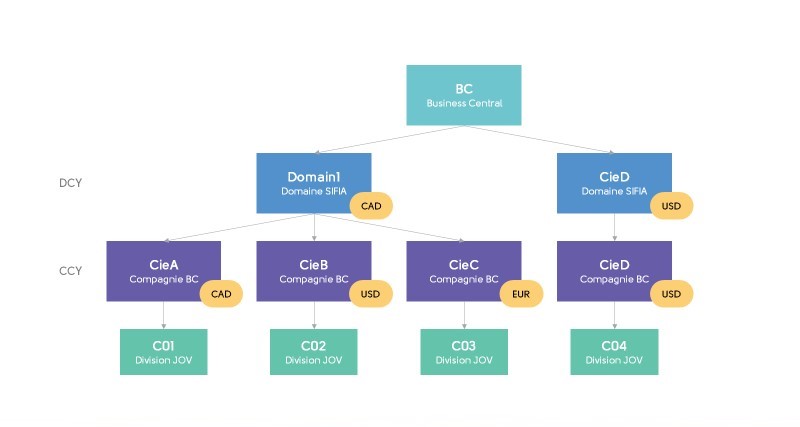OMZY Concept
By creating OMZY, JOVACO filled a gap in the accounting software sector and stood out in the SMB sector with a product that lets these organizations manage projects from a single organizational environment or a multi-company environment.
OMZY builds on this concept with a software that allows for real-time tracking of project profitability and productivity. Additionally, through its billing module, it addresses the most specific needs of the industry.
It is important to understand that this concept is closely tied to a domain that is itself integrated into Microsoft Dynamics 365 Business Central.
Organizational Structure
It is necessary to first outline the organization’s structure in order to establish the necessary elements for project management in one, or possibly multiple, domains.
Here is an example of a schematic representation:

In this plan, we can see, among other things, a domain itself divided into three distinct companies: Company A - Company B - Company C.
Whether the three companies operate in different currencies or not, the management will be that of multi-company accounting.
The Domain, if applicable, consists of several tax-wise and legally distinct companies, each possessing their own resources, equipment, etc.
The concept of a domain - created by JOVACO - is purely organizational and does not represent a legal entity. The domain oversees the companies and allows for interactions between them in a multi-company context when they need to share resources for a project.
The original time and expense allocation transactions come from the domain in a batch associated with the company to which the resources belong. Payables, on the other hand, are processed directly in the company.
The project itself belongs to the domain and is associated with the company that invoices for it. In a resource-sharing context, “Due to” (Payables) and “Due from” (Receivables) entries will be generated in the General Ledger. The lending company will want to cover the costs incurred, which are not billable internally, with revenue.
It is possible to have more than one domain, especially when a company manages completely different operations that do not share anything; a portion of this structure could be detached for resale without affecting the other domains. In this situation, each domain is independent, without sharing, and has its own configurations.
Licenses
Based on the same diagram above, one will choose either of the available license types:
Enterprise: Projects managed in a domain itself divided into one or more companies
Basic: The domain is also the company
To access this page: JOV License
Enterprise licence
In the Enterprise edition, the project domain can have multiple member companies, all operating under the same domain.
Only the configurations of JOV pages are required in the domain.
Under the Enterprise license, it is also possible to have companies that serve as their own project domain. These companies will then function like the companies in the Basic Edition. To do this, in the configuration of the JOV Company record, you need to check the “Is Domain” box for the respective company and select the company as the domain. This will result in the company’s name being identified as equal to that of the domain.
Basic license
In the Basic edition, all projects are managed within a single company. It is therefore not possible to define a domain and member companies. Each of the companies serves as both the domain and the company.